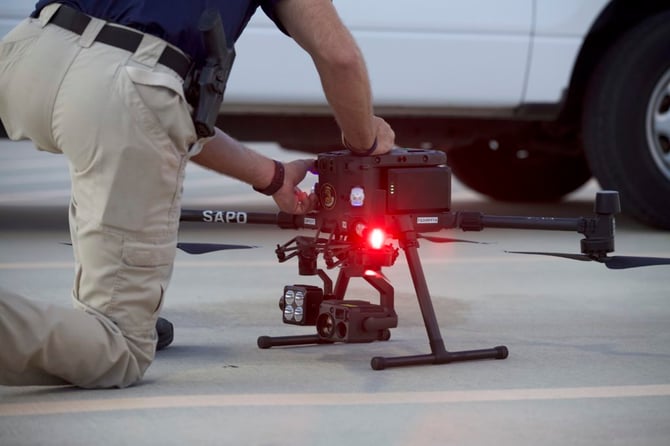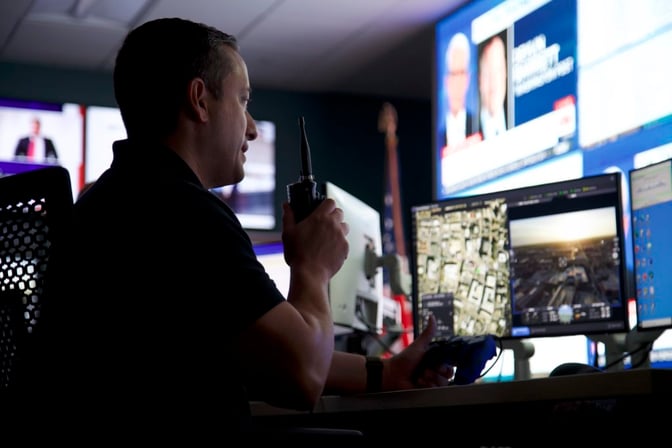Share this
Why Drone as First Responder Programs Are Leading the Way in Public Safety Innovation
by DroneSense on 1/14/25 5:00 PM
In 2025, law enforcement agencies across the United States are finding themselves at a critical juncture. With approximately 18,500 agencies employing around 810,000 officers and agents, challenges like recruitment shortages, increased retirements, and the growing complexity of public safety needs are pushing agencies to rethink how they operate.
While the number of officers has increased slightly in recent years, it hasn’t kept up with population growth. This leaves agencies stretched thin, managing more calls with fewer resources. To meet these challenges head-on, many are turning to technology, and drones have emerged as one of the most impactful tools in modern policing.
Drones: A Cost-Effective Solution for Modern Policing
Drones—technically known as unmanned aerial vehicles (UAVs)—are no longer just experimental gadgets. Today, they’re becoming indispensable assets for law enforcement. They’re faster to deploy, far more affordable than helicopters, and capable of doing many of the same tasks without the steep costs.
For decades, crewed aircraft like helicopters provided critical aerial support for law enforcement. However, their high costs meant only the most well-funded agencies could afford them. Enter drones: lightweight, agile, and equipped with high-resolution cameras and sensors. These devices make aerial support accessible to agencies of all sizes, enabling faster response times, better situational awareness, and improved officer and community safety.
A Closer Look: Montgomery County Police Department’s Drone as First Responder (DFR) Program
Montgomery County Police Department (MCPD) in Maryland is leading the charge with its Drone as First Responder (DFR) program. This innovative initiative, launched in late 2023, reimagines how police respond to emergencies by adding drones to the toolkit. The program’s mission is straightforward: to provide air support for 911 and police calls, helping officers respond faster and make better decisions in real time.
Here’s how it works:
- Drones are pre-positioned on rooftops within operational areas.
- When a 911 call or police-generated request comes in, the nearest drone launches and flies directly to the scene.
- Once on-site, the drone streams live video to officers, allowing them to assess the situation and make informed decisions.
- In some cases, the drone may even stabilize the situation without needing officers on the ground, freeing them up for other emergencies.
This program isn’t about surveillance or proactive patrolling. It’s designed solely to respond to active calls, ensuring transparency and maintaining public trust.

Why Drones Are a Game-Changer for Public Safety
Agencies like Montgomery County Police Department are proving that drones aren’t just high-tech toys—they’re transformative tools. Here’s why:
- Faster Response Times: Drones can often arrive at a scene in under two minutes, far faster than ground officers navigating through traffic.
- Improved Safety: Drones provide a bird’s-eye view of a situation, helping officers detect risks like ambushes or weapons before they arrive. This reduces the likelihood of harm to both officers and the public.
- Cost-Effectiveness: Operating a drone costs a fraction of what it takes to maintain a helicopter, making it feasible for agencies with tighter budgets.
- Better Decision-Making: Equipped with high-resolution cameras, thermal imaging, and other advanced sensors, drones give officers real-time insights to de-escalate situations or adjust their approach.
These benefits aren’t hypothetical. In Montgomery County, drones are already helping to track suspects, locate missing persons, and provide crucial intelligence during emergencies. They’re also reducing the strain on officers, allowing ground teams to focus on higher-priority calls.

Building Trust Through Transparency and Innovation
One of the most remarkable aspects of Montgomery County’s program is its commitment to transparency. The department has made it clear that drones will not be used for surveillance or other invasive activities. Instead, the focus is on providing faster, safer, and more effective responses to emergencies. This approach has helped foster trust with the community, showing that technology can be used responsibly to enhance public safety.
DroneSense: The Software Powering the Future of Policing
Technology like drones is only as good as the tools that support it. That’s where platforms like DroneSense come in. DroneSense is a software platform built specifically for public safety, offering features like:
- Remote control operations: Operators can manage drones from a command center, directing flights and monitoring live video feeds.
- Real-time video streaming: Command centers and officers can watch live feeds for situational awareness.
- Call integration: Seamless integration with 911 dispatch systems ensures drones are launched quickly when needed.
For programs like Montgomery County’s DFR initiative, DroneSense has become an essential partner, helping them maximize the potential of their drone fleet.
Drones Are the Future of Policing—And They’re Here Now
It’s clear that drones are no longer a futuristic concept for law enforcement—they’re a practical, impactful solution to some of today’s biggest challenges. Programs like Montgomery County’s DFR initiative show how technology can transform policing, making it more efficient, effective, and community-focused.
As more agencies embrace tools like drones, public safety will continue to evolve. Drones don’t just save time and resources—they save lives. With platforms like DroneSense leading the way, the future of law enforcement is smarter, faster, and more responsive than ever.
Ready to take your agency to the next level? Reach out to our team to learn how drones can help your department serve and protect more effectively. Together, we can make your vision for the future of public safety a reality.
Share this
- September 2025 (1)
- July 2025 (2)
- June 2025 (1)
- May 2025 (1)
- February 2025 (1)
- January 2025 (2)
- December 2024 (3)
- November 2024 (2)
- October 2024 (3)
- September 2024 (1)
- August 2024 (2)
- July 2024 (3)
- June 2024 (2)
- March 2024 (2)
- February 2024 (1)
- January 2024 (2)
- November 2023 (2)
- October 2023 (4)
- September 2023 (2)
- August 2023 (4)
- July 2023 (4)
- April 2023 (1)
- February 2023 (1)
- November 2022 (1)
- June 2022 (1)
- April 2022 (1)
- September 2021 (1)
- July 2021 (1)
- June 2021 (2)
- March 2021 (1)
- March 2020 (1)
- February 2020 (1)
- August 2016 (1)
.png?width=489&height=100&name=DS%20VTM%20Logo%20Horizontal%20-%20Color%20Light%20(2).png)